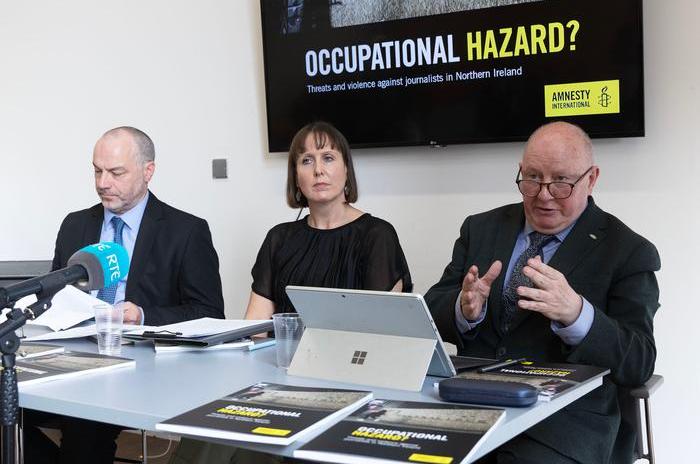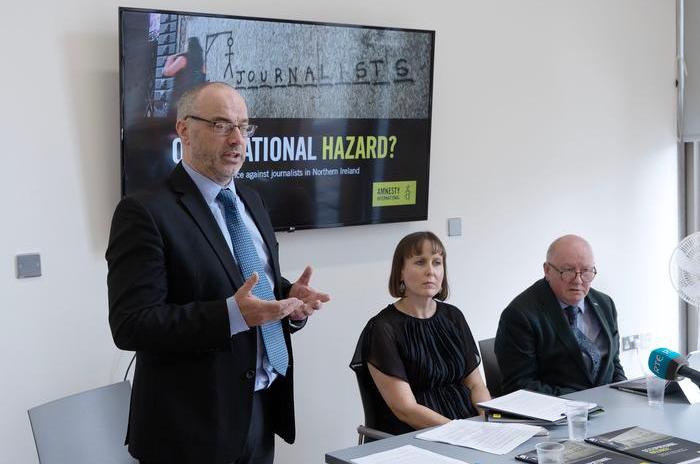Reporters speak out about ‘climate of fear’ in Northern Ireland amid paramilitary death threats
Journalists in Northern Ireland are facing regular death threats and attacks, with few of the perpetrators prosecuted, according to a new report by Amnesty International.
Séamus Dooley, NUJ assistant general secretary, has welcomed the report for revealing the scale and severity of threats, intimidation, and violence against journalists in Northern Ireland.
Amnesty described the country as the “most dangerous place in the UK” for journalists, after conducting a series of interviews with reporters who have been told they will be shot, stabbed, or threatened with bombs under their car due to their work.
Some have also been given 48-hour ultimatums to leave the country, whilst others have been physically attacked, their equipment damaged, or their cars hit with poles laced with nails. To protect themselves, some have also had their homes fitted with bulletproof windows and their doors with alarms linked to police stations.
Amnesty’s report, Occupational Hazard? Threats and violence against journalists in Northern Ireland, says that most of the threats “come from a range of proscribed paramilitary groups, loyalist and republican, as well as from armed organised crime groups, some with links to paramilitaries.”
During Amnesty’s research it emerged there have been more than 70 incidents of threats or attacks on journalists in Northern Ireland since the start of 2019 but most go unpunished; there have not been any prosecutions for any threats from paramilitary groups.
The 22 journalists who were interviewed for the study said they had “little expectation” that those who threatened them would be held to account and many felt the Police Service of Northern Ireland (PSNI) has not effectively investigated threats; since June 2022, there have been only two successful prosecutions for threats against journalists.
For decades some reporters have felt that dealing with threats was just part of their job - an “‘occupational hazard’ they have been forced to accept”, said Amnesty. It added: “But now, by coming together and sharing their stories, journalists in Northern Ireland are saying ‘enough is enough.’”
The report highlights cases including:
- Belfast Telegraph crime correspondent Allison Morris, whose house was visited nine times between December 2023 and October 2024 by police over threats from paramilitary or criminal groups. On one occasion, she received a threat and 24 hours later a pipe bomb was found near her home. Morris said: “I’m convinced someone’s going to kill me at some point. I always think I’ll never die of natural causes. Most of the time, I pretend that the threats don’t annoy me, but clearly, they do. This is not a normal way to live.”
- Sunday World northern editor Richard Sullivan said: “I’ve had threats to kill me, to use a bomb on my car and on my house. I’ve been given 24 hours to leave the country.”
- Sunday Life journalist Ciaran Barnes said: “I’ve got bulletproof windows front and back. I’ve got a bulletproof door. I’ve got cameras all around the house. I’ve got sensor activated lights and panic alarms.” The home security measures are paid for by his employer, as journalists are ineligible for access to the government’s Home Protection Scheme.
Speaking this morning at a press conference in Belfast, Séamus Dooley said:
“The report makes for grim reading and should serve as a wakeup call: to the police, to those involved in the administration of justice, to politicians, to those who control online platforms and crucially to all of us work in the media industry, including editorial executives and HR managers.
“The onus is now on us to respond to these stark findings and to build on some of the measures already in place – and to develop new, collaborative structures to protect journalists and journalism in Northern Ireland.
“The NUJ Safety Tracker, referenced in this report, is a new innovation and is a UK wide response to a mood change in the industry. At last, the silence about violence, threats, intimidation, and abuse has been broken and that is reflected in the response to this survey. The fact that so many prominent journalists were willing to speak on the record is highly significant.
“There is strength in unity, and I would encourage those of you who are not members of the NUJ to join us. I would also appeal to all employers who claim to care about the health, safety, and welfare of workers to respect the right of those same workers to join unions and to be collectively represented. À la carte commitments to human rights must be consigned to history.
"I welcome the very strong focus in this report on the unresolved murder of my NUJ colleague Martin O’Hagan. The fact that no one has faced justice for his murder remains a stain on the history of policing in Northern Ireland. We urgently need to see the report of the Police Ombudsman and that publication should clear the way for an independent, external investigation into his killing and the circumstances surrounding his murder. We will never allow the murder of Martin O’Hagan to become another forgotten file. The fact that no one has been successfully prosecuted sends a signal to those who seek to intimidate and threaten the media, that in Northern Ireland journalists are fair game, that this is a place where you can get way with murder.”

Séamus Dooley, seated next to report authors Kathryn Torney and Patrick Corrigan, speaks at the press conference.
© Kevin Cooper
Patrick Corrigan, Amnesty International UK’s Northern Ireland director, said:
“Journalists in Northern Ireland are facing a sustained campaign of threats, intimidation and violence from armed groups, which makes it the most dangerous place in the UK to be a reporter.
“They are being threatened, attacked and even killed for shining a light on paramilitary groups and others who seek to exert control through violence. This creates a climate of fear that many assumed was consigned to history when the Good Friday Agreement was signed.
“Yet there has not been a single prosecution for threats against journalists from paramilitary groups. This sense of impunity only emboldens those behind the threats.
“When journalists are under attack, press freedom is under attack. The state must create a safe environment where journalists can work freely and report without fear of reprisals. It is currently failing to do so.”

Patrick Corrigan speaks at the press conference alongside Kathryn Torney and Séamus Dooley.
© Kevin Cooper
Recommendations
Amnesty has made a number of recommendations for the police and government departments to act upon, including:
- Justice Minister Naomi Long MLA should establish and chair a new Media Safety Group, with representatives from the PSNI, Public Prosecution Service (PPS), media organisations and the NUJ, to deliver a new journalist safety strategy
- The PSNI must review its procedural response to threats and attacks against journalists and conduct investigations capable of leading to successful prosecutions
- The PSNI must produce new guidance and training for officers on the protection of journalists during public disorder
- The Northern Ireland Office and Department of Justice should ensure at-risk journalists can access the Home Protection Scheme
- The UK government should establish an independent public inquiry into the 2001 murder of Martin O’Hagan if the expected Police Ombudsman’s investigation finds serious failings or wrongdoing by the police
About the Journalist Safety Tracker
The NUJ’s Journalist Safety Tracker is designed to capture incidents submitted by journalists about the unacceptable abuse encountered through the course of their work. The online resource open to NUJ members and non-members, seeks to create an evidence base that informs the union’s campaigns and discussions with policy makers, on the need for improved protections for journalists.
Using the tracker, journalists can inform the union of incidents including those that occur online, in-person, are targeted at themselves or family members, are related to equipment damage, or involve the use of spyware. The tracker also captures information on ‘lawfare’, including legal communications that are aggressive, intimidatory, threatening or abusive and those considered Strategic Lawsuits Against Public Participation (SLAPPs).
